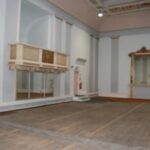
Archaeologists working on the £8m restoration of The Charterhouse have uncovered rare 14th century remains that shed new light on life in historic Coventry.
The Grade I listed former Carthusian Monastery, which once restored will be a major new heritage attraction, is proving to be one of the richest sites for discoveries in the West Midlands in recent years as works are uncovering layers of history.
The Prior’s House and Refectory of the monastery, which was founded in 1385, remain today and have the only intact interiors of any Carthusian building in the UK. The church, monks’ cells and chapter house were demolished in the Dissolution, although some 400m of tall stone precinct walls remain.
Now, archaeologists have discovered additional Elizabethan wall decoration inside the Prior’s House and, beneath later Victorian coverings, a likely monastic tiled floor which is made up of patterns and vivid colours found in tiles elsewhere on the site and made locally in the Middle Ages by Coventry’s substantial tile industry.
The tiles, and a 14th century arch also just discovered, are in a passageway along which a few selected visitors were invited into the monastic settlement. Careful conservation could bring this space back to its full medieval context.

David Mahony, the Conservation Architect at PCPT Architects, said:
“The discovery of more wall decoration on the first floor suggests that, when the monastery was converted into a house in the 1570s, large parts of the walls were decorated in black and white patterns and caricatures in a style very popular at that time.
“External excavations have been done in a piecemeal way in the past and this left an incomplete picture of what the monastery was originally like. Carthusian monasteries were built to a fairly standard layout which has enabled a best guess, but we are now starting to fill in the gaps. We recently uncovered remains of a substantial stone building which looks very likely to be the Chapter House and it is exactly where it should be.
“The team believe these are some of the most exciting recent archaeological discoveries in the region.”
Historic Coventry Trust is working in partnership with Coventry City Council and the local community on the £8 million project to restore one of Coventry’s oldest buildings, which is located off London Road near the city centre. The restoration is a major part of £30m of investment in the city’s heritage for Coventry’s tenure as UK City of Culture in 2021.

The Charterhouse has been a real hot bed of discovery for archaeologists from University of Leicester Archaeological Services, architects PCPT and conservation contractors Splitlath, who have been excavating the inner precinct area of the monastery and restoring the Prior’s House. The works are funded by the National Heritage Lottery Fund, Historic England and donations from several Trusts & Foundations.
The visitor attraction is due to open in the spring of 2021 and will include interpretative displays which explain the lives of the Carthusian monks, their cultural importance and influence, as well as the later Elizabethan conversion to a house during Robert Dudley, Earl of Leicester’s ownership.
Two of the original eleven monks’ cells that lined The Great Cloister will be reconstructed on their original foundations. One will show how the monks lived and the other will be an acoustically insulated room exploring the concept of silence – the Carthusians were the only monastic order to live in strict silence.
The project is being funded by the National Heritage Lottery Fund, Coventry City Council, Historic England and a number of Trusts and Foundations.
Our thanks to the Historic Coventry Trust for this story – you can sign up for their newsletter on the home page.

